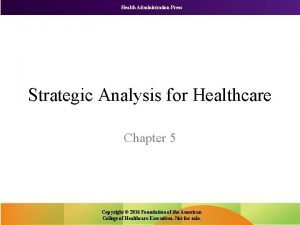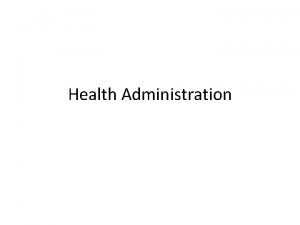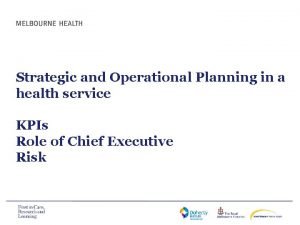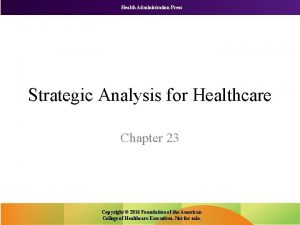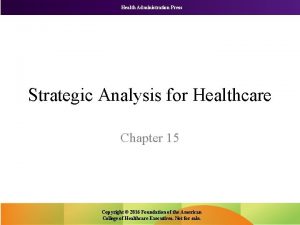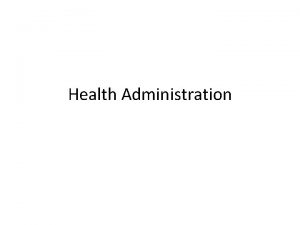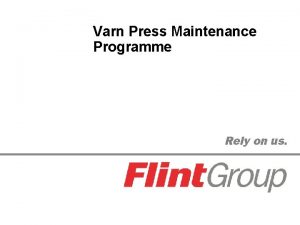Health Administration Press Strategic Analysis for Healthcare Chapter












- Slides: 12

Health Administration Press Strategic Analysis for Healthcare Chapter 18 Copyright © 2016 Foundation of the American College of Healthcare Executives. Not for sale.

Health Administration Press Internal Factor Evaluation • Just as an external factor evaluation (EFE) organizes and evaluates the OT section of SWOT, an internal factor evaluation (IFE) addresses the SW section—the internal strengths and weaknesses. • The IFE produces a numeric score that reflects the gravity of each issue listed. • The score will correspond to certain standard strategies that will be discussed in Chapter 19. Copyright © 2016 Foundation of the American College of Healthcare Executives. Not for sale.

Health Administration Press Internal Factor Evaluation • As you did with the EFE analysis, note that not every item you identified in the SW section of your SWOT analysis is of equal strength or equal weakness. • Some distinction needs to be made between the “great” strengths and weaknesses and the “could be” strengths and weaknesses. • To begin to make these distinctions, review the SW section of SWOT from the previous chapter. Copyright © 2016 Foundation of the American College of Healthcare Executives. Not for sale.

Health Administration Press Internal Factor Evaluation • The strategist evaluates each strength and weakness and applies a weighting system. • The total when all of the weights have been applied and added is exactly 1. 00. • Each individual factor, therefore, receives some portion of 1. 00. • The size of that portion reflects the strategist’s subjective evaluation of how important each internal factor is to successful competition within the firm’s industry. • The more important the factor, the higher is the weight assigned. • The total of 1. 00 is the sum of the whole column, including both strengths and weaknesses. Copyright © 2016 Foundation of the American College of Healthcare Executives. Not for sale.

Health Administration Press Internal Factor Evaluation Copyright © 2016 Foundation of the American College of Healthcare Executives. Not for sale.

Health Administration Press Internal Factor Evaluation • The previous slide shows, for instance, that the weakness associated with managing a significant population without health coverage is deemed to be more significant than the strength of the organization’s technology, administration, or facilities. • Note that there is no one “correct” weight for any factor. • The accuracy of the analysis depends on the strategist; careful research and a clear understanding of the company and industry are essential. Copyright © 2016 Foundation of the American College of Healthcare Executives. Not for sale.

Health Administration Press Internal Factor Evaluation • Once weights have been assigned to the importance of each factor in the industry, the strategist now focuses on how significant each strength or weakness is for the organization. • Strengths and weaknesses are rated on a scale of 3 – 4 for strengths and 1– 2 for weaknesses, as shown here: 4 = major strength 3 = minor strength 1 = major weakness 2 = minor weakness Copyright © 2016 Foundation of the American College of Healthcare Executives. Not for sale.

Health Administration Press Internal Factor Evaluation • The rating for each factor is once again subjective on the part of the strategist and should be based on research. • These ratings are not added up, so there are no constraints on how the numbers may be distributed. • Once the ratings have been applied, each factor’s rating is multiplied by its weight to yield a weighted score for the factor. • The next slide continues this example. Copyright © 2016 Foundation of the American College of Healthcare Executives. Not for sale.

Health Administration Press Internal Factor Evaluation Copyright © 2016 Foundation of the American College of Healthcare Executives. Not for sale.

Health Administration Press Internal Factor Evaluation • The IFE analysis yields a total score when the column of individual scores is summed. • This score can be used in an internal–external (I/E) matrix, which corresponds to a standard table of strategic responses. • We will explore these steps in the next chapter. Copyright © 2016 Foundation of the American College of Healthcare Executives. Not for sale.

Health Administration Press Internal Factor Evaluation • Note that the weight is industry specific. • The rating is organization specific. Copyright © 2016 Foundation of the American College of Healthcare Executives. Not for sale.

Health Administration Press Exercise • Break into groups and complete an IFE chart in the space provided on page 123 of your book. • You will need the SW portion of SWOT that you completed in the last chapter. Copyright © 2016 Foundation of the American College of Healthcare Executives. Not for sale.
 Health administration press
Health administration press Healthcare and the healthcare team chapter 2
Healthcare and the healthcare team chapter 2 Sports medicine definition
Sports medicine definition Uncw mpa
Uncw mpa Uic healthcare administration
Uic healthcare administration Healthcare administration in athletic training
Healthcare administration in athletic training Health administration definition
Health administration definition Strategic analysis and choice in strategic management
Strategic analysis and choice in strategic management Strategic and operational planning in healthcare
Strategic and operational planning in healthcare Monash university master of public health
Monash university master of public health Gmu hap
Gmu hap Apk 2300 ucf
Apk 2300 ucf Veterans health administration organizational chart
Veterans health administration organizational chart
